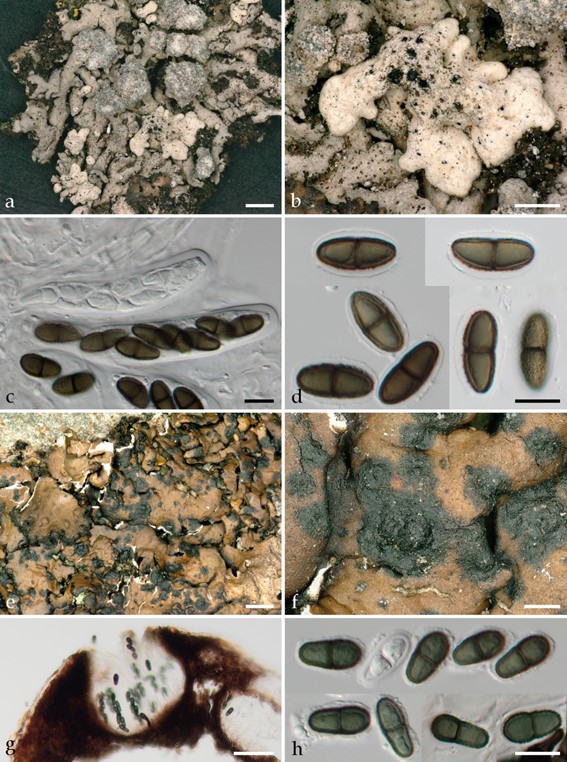Polycoccum Saut. ex Körb., Parerga lichenol. (Breslau) 5: 470 (1865).
MycoBank number: MB 4309; Index Fungorum number: IF 4309; Facesoffungi number: FoF 08782; 41 morphological species (Species Fungorum 2020), 4 species with molecular data.
Type species: Polycoccum sauteri Körb.
Notes: Polycoccum is considered as polyphyletic, with species being presented in two distantly related clades in Trypetheliales and Pleosporales (Ertz et al. 2015). Polycoccum sensu stricto and species of Clypeococcum form a lineage in Trypetheliales, thus Ertz et al. (2015) established Polycoccaceae to accommodate these genera. Polycoccum sensu stricto (in Polycoccaceae) is characterized by ascomata formed on the host thallus, induce the formation of galls, thick-walled with cells ± isodiametric in longitudinal section, relatively thick paraphysoids, broadly cylindrical to subclavate asci, generally with irregularly distichously or irregularly uni-seriate arranged ascospores, often distinctly ornamented ascospores (Ertz et al. 2015). The genus has 57 species accepted by Lawrey and Diederich (2015) and new species are described almost every year (Ertz et al. 2015). It has become one of the most species-rich genera of lichenicolous fungi. The most complete key to species of Polycoccum so far was provided by Hawksworth and Diederich (1988). Other regional keys were established such as key for 13 species from Spain (Atienza et al. 2003), and key for 14 species from Sweden (Ihlen and Wedin 2008), and a key for 13 species from France (Gardiennet 2012) (Fig. 76).

Fig. 76 Morphology of genera in Polycoccaceae (a–d = Polycoccum pulvinatum, Belgium, Ertz 18114 (BR); e–h = Clypeococcum cladonema, Belgium, Ertz 15260 (BR)). a, b Galls with immersed ascomata on Physcia caesia. c Asci with ascospores in water. d Ascospores in water, the one in the lower right corner showing the verruculose surface. e, f ascomata (= black areas) on Xanthoparmelia (= brownish host thallus). g Section of ascomata in water. h, ascospores in water. Scale bars: a, e = 1 mm, b = 500 µm, f = 250 µm, g = 50 µm, c, d, h = 10 µm
Species
